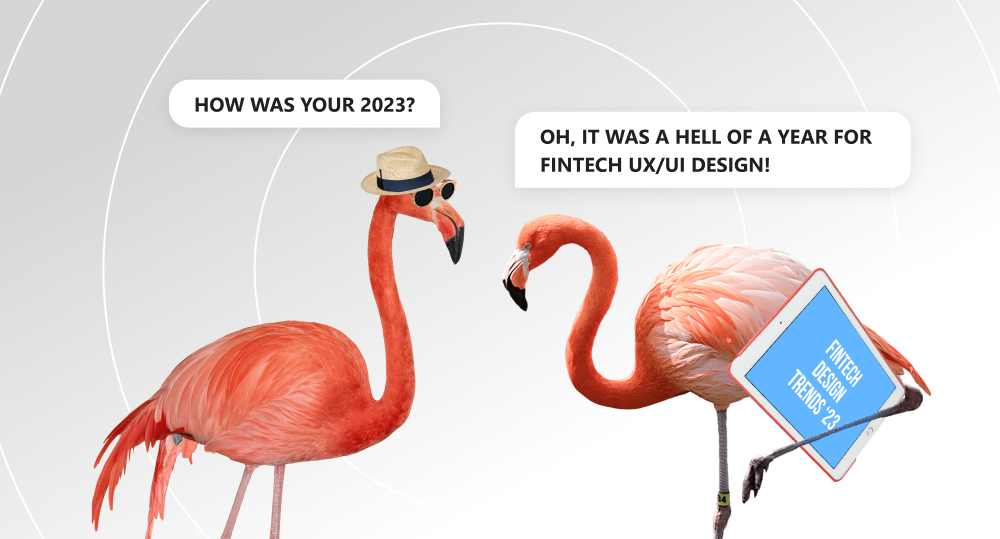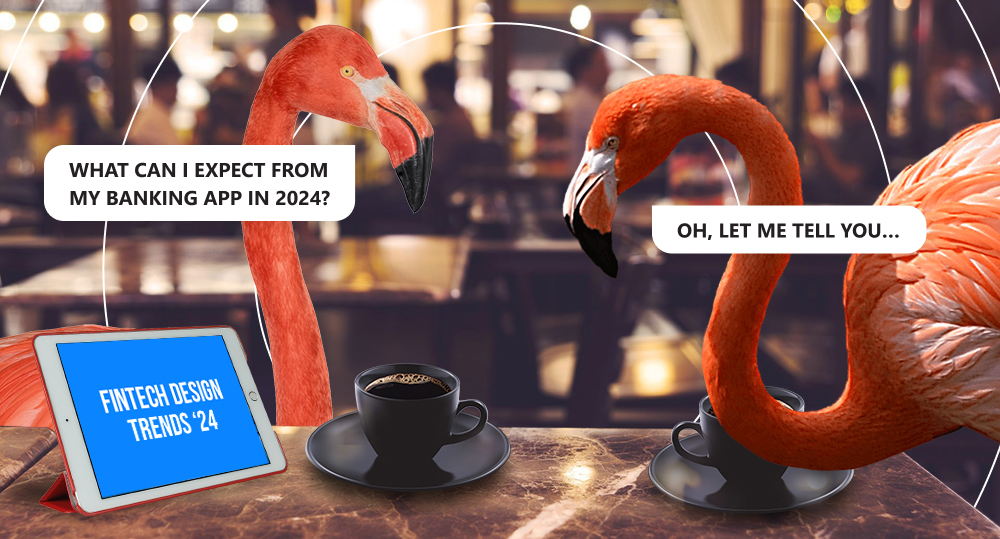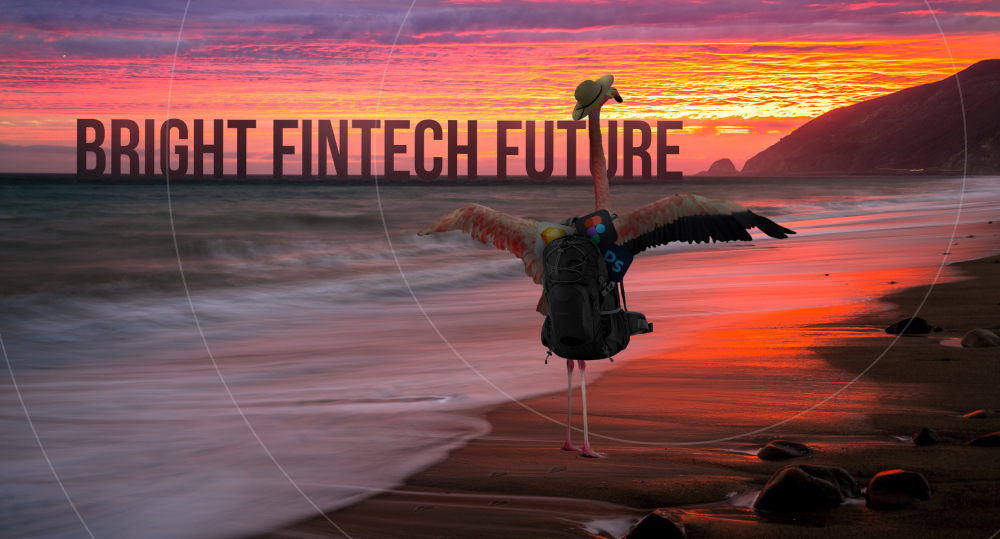You won't find the words “overdraft”, “accrued interest”, or “mortgage” on the home page in today's banking software. Now, when you want to check your account balance, you open the app, and it greets you with a caring “Hello, Alex! How are you today?” A change like this is significant progress for traditional banks, which have always lacked user friendliness. It seems financial companies aren't going to stop there, and we can only wonder how fintech UX/UI web design will further evolve. Is it so?
To avoid guesswork and know exactly what to expect from the fintech industry, let's examine the trends that 2023 brought us and take a look at what 2024 has in store. Are you in?
written by:
Lizaveta Starykava
Senior Designer
Contents
Intro: The Fintech Evolution
The financial technology, or “fintech”, landscape has undergone a dramatic evolution in recent years. With the advent of mobile technology and the rise of digital-only banks, fintech is drastically transforming the way we bank, invest, and manage our money. It’s also having a huge impact on the economy, making it faster and easier for businesses to obtain funding, manage their budgets, and reach new customers. Along with that, it creates new jobs and economic opportunities.
To illustrate this, let's look at some recent statistics from the financial sector.
- Transactions in the Global Digital Payments Market are expected to grow to $19.9 trillion by 2026. (Fortune Business Insights)
- 96% of global consumers are aware of at least one fintech company. 64% of them have experience using one or more of its services. (EY)
- 82% of traditional banking businesses plan to partner with fintech companies in the next 3–5 years. (PWC)
- The total revenue of the fintech industry has doubled since 2017: from $84.2B to 183.1B. (Deloitte)
- Currently, there are over 26,000 fintech startups across the globe. (BCG)
The above figures prove that the development of fintech is a trend that is likely to continue, as more people realize its immense potential.
Yet, technology is not the only driver of fintech's success. At its forefront are satisfied consumers. What is the first thing the average user sees when opening an app? The interface. A balanced and user-friendly UI/UX design is the kind of “wrapper” for dry financial language that helps attract and retain new users.
Now let's briefly look back at the past year and see what tricks designers used in 2023 that managed to win the hearts of users.
Exciting Things Happened to Fintech Website Design in 2023
2023 was a hell of a year for fintech product design! We saw a surge in innovation and creativity, with new ideas and products flooding the market. From sleek and personalized interfaces to ultra-secure cryptocurrency wallets, there was something for everyone. What were the most outstanding developments? Here are a few of our favorites:
Clear Language
In 2023, we observed a shift away from confusing jargon and technical wording in favor of clear, concise, and easy-to-understand copy. This made any web or mobile banking app more accessible to a wide range of users. The trend has helped build customer trust, which is essential in the world of finance. After all, if people can't understand what you offer, they're unlikely to hand over their hard-earned cash.
Good Examples:
- Monzo. It's a fintech app that showcases the results of the outstanding work of designers and copywriters — a human language approach. The platform uses friendly everyday language that everyone can understand.
- Cleo. It's a useful chatbot with a snappy personality, making it a hit with young people. Cleo sends users memes and emojis, responds to their messages with cheeky comments, and teases them while providing high-quality and quick help with managing personal finances.
Personalization
One of the other popular fintech design principles in 2023 was personalization — creating a unique, customized experience for each user. This can be done in several ways: tailoring the user interface to their preferences, providing individualized recommendations, or offering personalized customer support.
Why personalization? First, users are increasingly savvy and expect their financial apps and websites to focus on their specific needs. Second, personalization can enhance user experience by facilitating and speeding up the search for relevant information and features. Finally, it can help fintech businesses establish deeper relationships with their clients and win over the competitors.
Good Examples:
- Mint. It's one of the few fintech apps that don't require a bank account or credit score. All the user has to do is to create a profile and link their banking accounts. Mint will then provide customized insights and recommendations on how to improve financial health.
- Betterment. It's a personalized manager of investments. Betterment considers the user's unique circumstances and goals and provides customized advice, investing strategies, and automatic savings plans.
Vivid Color Palettes
The past year has seen a lot of experimentation in fintech UI design. Bright color schemes, unusual screen loading, vibrant and blurry backgrounds, authentic graphics have all become popular choices for user experience designers. What made them choose this style instead of the minimalism and conformism pertaining to banking?
It's probably a response to the growing demand for more user-friendly and engaging fintech products. For example, such visual component as lively colors can influence the user's mood and create an attractive atmosphere, forming positive associations with the product. At the same time, a blurred background shifts attention to text and objects in the foreground, which helps users focus.
Good Examples:
- Monese. The creators of this app developed a fintech design, thinking about users' feelings, not their money. That's why its interface turned out lively and bright, with animated reactions to certain positive financial events, such as a salary or debt repayment.
- Emma. This is another example of a money management app with a user-friendly design. The clear background and attention-grabbing colors make the platform's interface welcoming, fresh, and cheerful.
Digital Wallets and Cryptocurrencies
Born a few years ago, technologies such as cryptocurrencies and digital wallets remain the hottest trends in fintech UX design. This tendency is driven by the younger generation, who more willingly accept digital money management. Cryptocurrencies are gaining traction, as they also offer a unique and secure way to invest and trade.
These two trends are poised to get more mainstream, as more fintech companies begin to incorporate them into their products and services.
Good Examples:
- Coinbase. With this app, users can buy and sell digital currencies, track their prices, and manage their cryptocurrency portfolio. The secret to Coinbase's success lies in its user-friendliness, stellar security measures, and personalized features.
- Cash App. Whether a user needs to split a bill with friends, pay the babysitter, or shop online with cryptocurrency, this app offers a reliable and convenient platform for managing finances. Besides being peer-to-peer, which ensures upscale security, the service provides advanced features such as investing in stocks or buying Bitcoins.
Data Visualization
One more successful focus area of designing for fintech software is data visualization. By taking complex data sets and representing them in a visually appealing way, companies make their products more convenient, entertaining, and approachable to a larger audience.
Data visualization is not only helpful for savvy users, but can also be applied to communicate complex financial concepts to non-experts. Here are some top examples we've seen so far:
- Interactive and animated elements;
- 3D visualization;
- Storytelling;
- 360-degree visualization;
- Augmented reality visualization.
Good Examples:
- MoneyLion. The data visualization feature sets this platform apart from other banking apps. MoneyLion gives users a bird's-eye view of their finances, helping them make better decisions about their money. It uses information from bank accounts, credit cards, and investments and displays it in easy-to-understand diagrams and charts.
- Acorns. This personal finance app helps users invest their spare change, earn bonus investments, and grow money over time. Acorns also offers a variety of data visualization tools to help track progress and see how investments are doing.
Where Is 2024 Taking Us in Fintech UI/UX Design?
The landscape of fintech web design and mobile interfaces will keep evolving rapidly in 2024. With the rise of smart technologies like artificial intelligence and blockchain, fintech businesses will need to build their products with these advancements in mind.
What can we expect to see in the world of UI/UX design for fintech? Here are a few predictions:
Gamification Elements
As we move into the future, we can notice more fintech projects incorporating gamification into their UI/UX design. This is a great way to engage users and keep retention levels high. Moreover, such an approach turns stressful budgeting management into an entertaining game-like experience, encouraging healthy financial behavior.
Some of the most popular gamification elements are points, levels, challenges, in-app currency, leaderboards, and rewards for reaching certain milestones.
Good Examples:
- Nubank. It's a Brazilian fintech startup that offers gamification features in its Nunos app to engage and educate users about their finances. Nubank gives away rewards for completing tasks like paying a bill, depositing money into an account, or using a credit card.
- Fortune City. This unique app allows users to track their finances by turning money management into a simulation game. How does it work? The user records their income and expenses as in a traditional budget app, but each such entry generates a specific type of building. As a result, the user has an entire city with buildings illustrating all their savings and expenses over a certain period in an unusual and visually appealing way.
Artificial Intelligence
AI's superpowers keep inspiring developers to create interactive mobile and web design for fintech software. Below are some of its most common uses:
- Virtual assistants for helping customers manage their finances;
- Chatbots for timely and human-like support and 24/7 guidance throughout the app;
- Robotic Process Automation (RPA) for streamlined and automated work processes;
- AI-powered data visualization;
- Intelligent personalization for providing specialized financial advice;
- Face, fingerprint, and speech authentication.
Good Examples:
- Erica. Remember Cleo? Erica is its polite and highly professional sister who works for Bank of America. Although it doesn't allow itself to crack jokes, anyone who interacts with it is amazed at its human and thoughtful approach. This is the result of the hard work of 100+ engineers and innovative technologies such as machine learning, cognitive messaging, and advanced analytics.
- Fintin. It's another advanced AI-based financial product with an interface created with natural language processing. The app offers customers personalized services — financial plan, spending tracker, digital assistant — by analyzing their past behavior and business interactions.
Blockchain Technology
One of the most exciting trends we foresee is the further development of blockchain technology, which enables secure, transparent, and tamper-proof transactions. This makes it ideal for fintech applications such as payment services, remittances, trading, and settlements.
At the moment, there is a huge stumbling block in the application of the technology in different parts of the world. Guess what it is? Before embarking on a blockchain-based platform, it's critical for developers to research financial regulations, such as anti-money laundering (AML), and make sure the product complies with them.
These regulations are unique to various countries and describe the rules for blockchain in a particular region. Take cryptocurrency, for example. In countries such as Canada and Singapore, cryptocurrency exchange is legal and regulated by relevant acts (the Virtual Currency Travel Rule in Canada and the Payment Services Act 2019 in Singapore). At the same time, China has imposed a complete ban on the use of digital currencies.
Good Examples:
- Wirex. It allows users to store, buy, and exchange digital and traditional currencies in one place. Wirex uses blockchain technology to offer a more secure and efficient way of handling transactions.
- Ripple. The app's key features are fast international transaction time (8 seconds), low fees, and an added security layer provided by blockchain technology. Ripple is available in over 80 countries and is used by major banks and financial institutions worldwide.
Centralization
While blockchain brings decentralization to a fintech design system, the industry is also trending toward centralization. This means that instead of having a bunch of financial apps on their phones, users can install a platform serving as a one-stop-shop for all their needs. Such centralization gives people an easier way to manage their money and makes the industry more accessible to newcomers.
What does this signify for designers? They'll have to focus more on creating user-friendly interfaces that can perform a variety of tasks. As we move toward a more centralized financial industry, they should also be mindful of how their fintech graphic design can help people navigate this new landscape.
Good Examples:
- Revolut. This fintech service enables users to manage all their finances in one place by opening a bank account right in the app. Revolut makes it easy to track expenses, set budgets, manage subscriptions and investments, and transfer money between accounts.
- Inly. It's a fintech product with a host of useful tools to help businesses manage their finances. With Inly, teams can create financial documents (invoices, contracts, or proposals), send and receive money transfers, use the payment calendar, get notifications about important financial events, and track their balance through an intuitive dashboard.
Banking Apps Went Social
Fintech businesses are increasingly incorporating social media like Facebook, Twitter, or Instagram into their platforms. This trend allows companies to keep in touch with clients and provide faster service, while enabling users to connect with friends and family to discuss financial goals and strategies. The tendency is especially popular among millennials and Gen Zers, who are more comfortable using social media to communicate than older generations.
Good Examples:
- Zopa. It's a P2P lending platform from the UK. To make peer-to-peer lending approachable and entertaining for everyone, the Zopa team publishes tons of education content on their Instagram and blog. Users can find all kinds of creative content there: comic stories, funny images, live polls, and more.
- Honeydue. What sets this platform apart from other fintech apps is its social features. Honeydue aims to simplify money management for couples. It allows them to connect their financial accounts and then view their partner's recent activity feed. This can be useful for catching financial red flags early, or just keeping tabs on what your partner is spending.
These are just a few of the many mind-blowing things we can expect to see in the world of fintech app UI design this year. Stay tuned and get ready for an exciting ride! Better yet, join the trend-setting movement and launch a promising fintech product with a dedicated team of fintech software developers.
What This Means for the Future of Fintech App Design
We're seeing a myriad of positive fintech design trends. Today's financial apps are adopting a user-centric approach, focusing on intuitive style and an engaging user experience. We can also notice a shift toward a more open and collaborative fintech design system, with more software being built on open-source platforms.
All of these trends point to a bright future for financial technology. With more businesses turning to fintech solutions to streamline their operations, the demand for UI/UX designers willing to experiment with new ideas and technologies will only continue to grow.
The fintech revolution is just getting started, reshaping the way we live and work. The Qulix team is excited to be part of it and help you navigate this rapidly changing landscape. Contact us, and we'll create a new cutting-edge fintech product together!

Contacts
Feel free to get in touch with us! Use this contact form for an ASAP response.
Call us at +44 151 528 8015
E-mail us at request@qulix.com










